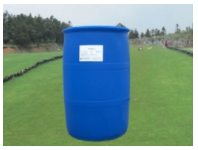Anionic surfactants are mainly used in the form of sulfonates and phosphates. In the early stage, most of the antistatic agents were sulfonates. However, due to the limitations of the use of these surfactants in the oil agents, and their lubrication and antistatic properties were inferior to those of phosphates, the anionic surfactants in the modern oil agents were mainly phosphates, especially the alkyl phosphates and their salts (apk) and their ethylene oxide (EO) adducts Excellent antistatic agent and lubricant in oil agent.
Apk is a common component in all kinds of fibers, especially in the short fiber oil agent. It has good antistatic and smooth properties, good heat resistance, less heat volatilization, and can increase the oil film strength to reduce the wear of the tow. Apk is usually produced by phosphorylation of high carbon alcohol (C12 ~ C16) and P2O5. The ratio of monodiester and diester is adjusted by hydrolysis, and then neutralized with KOH.

The smoothness of the fiber surface after oiling is usually expressed by the friction coefficient μ. The friction coefficient f / F μ between the fiber and the fiber and the friction coefficient f / m μ between the fiber and the metal are closely related to the oiling agent.
The static friction coefficient μ s and dynamic friction coefficient μ D of F / F are closely related to the alkyl length. When the carbon number of alkyl chain increased, the F / Fu decreased, and when the alkyl chain increased above C14, the change of μ s tended to be stable, while μ D increased. As the smoothness mainly depends on μ s, the carbon number increases, the smoothness increases, and the clustering decreases. Therefore, when APK is used, it is necessary to select a proper amount of alkyl carbon in the formula, and a satisfactory result can be obtained.
By adding antistatic agent into the oiling agent, the phenomenon of charged fiber can be overcome, which can eliminate the phenomena of wool, bulkiness, broken ends, winding roller, under cotton net and so on in the process of miscellaneous spinning, drafting and spinning. Apk has a good antistatic effect, especially in the case of high humidity. Antistatic properties are affected by concentration factors in APK:
1) The effect of APK alkyl carbon number on antistatic property: the increase of alkyl carbon number, the increase of hydrophobic group, the decrease of polar group, the decrease of hygroscopicity, the increase of static charge accumulation and the decrease of antistatic effect.
2) The effect of APK concentration (m) on anti-static: generally, the higher m, the better anti-static effect. For example, the antistatic effect of c18pk is worse than that of c12pk, but the difference decreases with the increase of M.
3) The influence of the ratio of monodiesters in APK on the antistatic property: in the preparation of APK, different proportions of monodiesters are produced due to the change of process conditions. Because APK in monoester contains two hydroxyl Sylvites, while APK in diester only contains one hydroxyl sylvite, the former is obviously more hygroscopic than the latter, while the static charge accumulation is less, and the antistatic performance is strong.